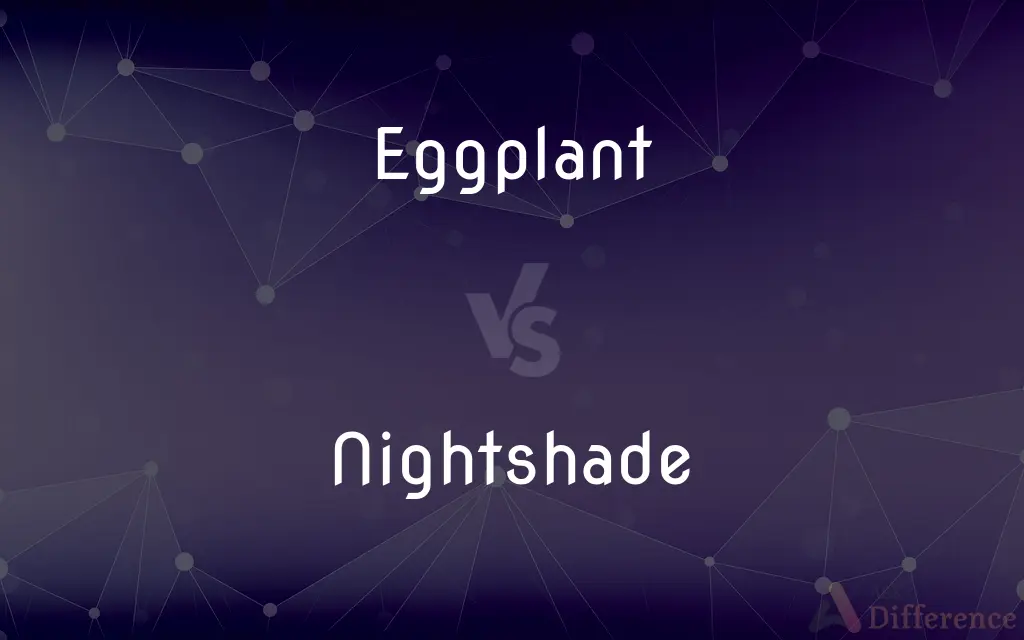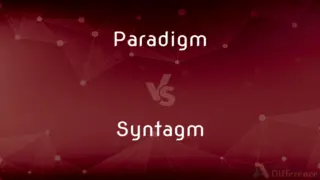Eggplant vs. Nightshade — What's the Difference?
Edited by Tayyaba Rehman — By Fiza Rafique — Updated on April 23, 2024
Eggplant, a popular garden vegetable known for its glossy, deep purple skin, belongs to the nightshade family, which includes various plants, some edible and others toxic.

Difference Between Eggplant and Nightshade
Table of Contents
ADVERTISEMENT
Key Differences
Eggplant is cultivated primarily as a food source, valued for its meaty texture and ability to absorb flavors in cooking. In contrast, nightshade refers to a broader family of plants, Solanaceae, which includes not only vegetables like tomatoes and peppers but also toxic varieties such as belladonna.
Eggplants are typically large, with a teardrop shape and a smooth, glossy finish that ranges from deep purple to white. Whereas nightshades encompass a wide range of plants with differing appearances, from small herbs to sprawling shrubs, often with berries or tubers.
The fruit of the eggplant is used extensively in cuisines worldwide, featuring in dishes like moussaka and baba ganoush. On the other hand, many nightshade plants are inedible or poisonous, with notable exceptions like potatoes and tomatoes that play significant roles in global diets.
Eggplant is particularly noted for its culinary uses, especially in vegetarian dishes where it serves as a substantial main ingredient. In contrast, other nightshade plants are often noted for their medicinal properties, such as tobacco for nicotine and belladonna for atropine.
While eggplants thrive in warm, temperate climates and require a long growing season, nightshade plants vary widely in their environmental preferences and growth conditions, adapting to a range of habitats from tropics to temperate zones.
ADVERTISEMENT
Comparison Chart
Classification
Solanum melongena
Family Solanaceae
Common Use
Culinary vegetable
Varied (culinary, medicinal, toxic)
Typical Appearance
Large, glossy, teardrop-shaped fruit
Diverse (berries, tubers, shrubs)
Edibility
Edible and commonly consumed
Ranges from edible to highly toxic
Growing Conditions
Warm climate, long growing season
Wide range, from tropical to temperate zones
Compare with Definitions
Eggplant
A dark purple, spongy fruit used widely in cooking.
She sliced the eggplant for her ratatouille.
Nightshade
A family of plants, scientifically termed Solanaceae, that includes both edible and toxic species.
The nightshade family includes diverse plants like tomatoes and belladonna.
Eggplant
A member of the nightshade family, known scientifically as Solanum melongena.
Eggplant is closely related to tomatoes and potatoes.
Nightshade
Known for the presence of alkaloids, some of which are poisonous.
Care must be taken when identifying wild nightshade to avoid toxic varieties.
Eggplant
Often used as a meat substitute in vegetarian meals.
They used grilled eggplant slices as burger patties.
Nightshade
Includes popular vegetables such as potatoes, tomatoes, and peppers.
Potatoes and tomatoes are among the most consumed nightshades.
Eggplant
Popular in global cuisines for its ability to absorb flavors.
He marinated the eggplant in olive oil and herbs before grilling.
Nightshade
Some species are used medicinally, such as belladonna and tobacco.
Belladonna, a nightshade plant, has been used historically in medicine.
Eggplant
Cultivated for its edible fruit.
Eggplant thrives in the garden alongside peppers and tomatoes.
Nightshade
Varies widely in plant form and habitat.
Nightshade can be found as herbs, shrubs, or vines.
Eggplant
Eggplant (US, Australia, New Zealand, anglophone Canada), aubergine (UK, Ireland, Quebec, and most of mainland Western Europe) or brinjal (South Asia, Singapore, Malaysia, South Africa) is a plant species in the nightshade family Solanaceae. Solanum melongena is grown worldwide for its edible fruit.
Nightshade
A plant of the nightshade family, especially a poisonous one of the genus Solanum or Atropa, such as bittersweet nightshade or belladonna.
Eggplant
The purple egg-shaped fruit of a tropical Old World plant, which is eaten as a vegetable; an aubergine.
Nightshade
Any of the poisonous plants belonging to the genus Solanum, especially black nightshade or woody nightshade.
Eggplant
The large plant of the nightshade family which bears aubergines.
Nightshade
(colloquial) Any plant of the wider Solanaceae family, including the nightshades as well as tomato, potato, eggplant, and deadly nightshade.
Eggplant
A plant (Solanum melongena) native to India, cultivated for its edible, glossy, usually ovoid fruits that are chiefly purple but can be white, yellow, or green.
Nightshade
Belladonna or deadly nightshade, Atropa belladonna.
Eggplant
A fruit of this plant. Also called aubergine.
Nightshade
Any of several plants likened to nightshade, usually because of similar dark-colored berries.
Eggplant
A blackish purple.
Nightshade
A common name of many species of the genus Solanum, given esp. to the Solanum nigrum, or black nightshade, a low, branching weed with small white flowers and black berries reputed to be poisonous.
Eggplant
The plant Solanum melongena.
Nightshade
Any of numerous shrubs or herbs or vines of the genus Solanum; most are poisonous though many bear edible fruit
Eggplant
The edible fruit of the Solanum melongena: an aubergine.
Eggplant
(North America) A dark purple color, like that of the skin of this fruit.
Eggplant
A black person (used mainly by Italian-Americans).
Eggplant
A 180 backside rotated invert in which the front hand is planted on the lip of the halfpipe wall
Eggplant
A plant (Solanum Melongena), of East Indian origin, allied to the tomato, and bearing a large, glossy, edible fruit, shaped somewhat like an egg; mad-apple. It is widely cultivated for its fruit, commonly eaten as a vegetable.
Eggplant
The fruit of the eggplant{1}.
Eggplant
Egg-shaped vegetable having a shiny skin typically dark purple but occasionally white or yellow
Eggplant
Hairy upright herb native to southeastern Asia but widely cultivated for its large glossy edible fruit commonly used as a vegetable
Common Curiosities
Can you eat all nightshades?
No, while some nightshades like tomatoes and potatoes are edible, others like belladonna are toxic.
Is eggplant easy to grow?
Eggplant requires warm temperatures and a long growing season, making it moderately challenging to cultivate.
What is eggplant?
Eggplant is a vegetable known for its large, dark purple fruit and usage in various dishes worldwide.
What are nightshades?
Nightshades are a plant family that includes a wide range of species, from edible vegetables to toxic herbs.
Where is eggplant most commonly used?
Eggplant is popular in Mediterranean, Middle Eastern, and Asian cuisines.
Can eggplant be eaten raw?
While technically edible, eggplant is usually cooked to improve texture and flavor.
How long does it take for eggplant to grow?
Eggplant typically takes about 100 to 150 days from seed to harvest.
What are the nutritional benefits of eggplant?
Eggplant is low in calories and contains fiber, vitamins, and minerals.
Are all nightshade plants poisonous?
Not all; many, such as peppers and eggplants, are safe and popular foods.
How do I identify edible nightshades in the wild?
Identification should be cautious due to the presence of toxic species; consulting a knowledgeable guide is recommended.
Which nightshade plants are most toxic?
Belladonna and certain other wild species are highly toxic and should be avoided.
What dishes are commonly made with eggplant?
Dishes like moussaka, ratatouille, and eggplant Parmesan feature eggplant prominently.
Do nightshades affect health?
Some people may experience sensitivity to nightshades, which can impact joint and digestive health.
Is eggplant a fruit or a vegetable?
Botanically, eggplant is a fruit, but it is commonly used as a vegetable in cooking.
What are the medicinal uses of nightshades?
Some nightshades, like tobacco and belladonna, are used for their alkaloids in various medicinal applications.
Share Your Discovery

Previous Comparison
Weight vs. Pressure
Next Comparison
Paradigm vs. SyntagmAuthor Spotlight
Written by
Fiza RafiqueFiza Rafique is a skilled content writer at AskDifference.com, where she meticulously refines and enhances written pieces. Drawing from her vast editorial expertise, Fiza ensures clarity, accuracy, and precision in every article. Passionate about language, she continually seeks to elevate the quality of content for readers worldwide.
Edited by
Tayyaba RehmanTayyaba Rehman is a distinguished writer, currently serving as a primary contributor to askdifference.com. As a researcher in semantics and etymology, Tayyaba's passion for the complexity of languages and their distinctions has found a perfect home on the platform. Tayyaba delves into the intricacies of language, distinguishing between commonly confused words and phrases, thereby providing clarity for readers worldwide.
















































